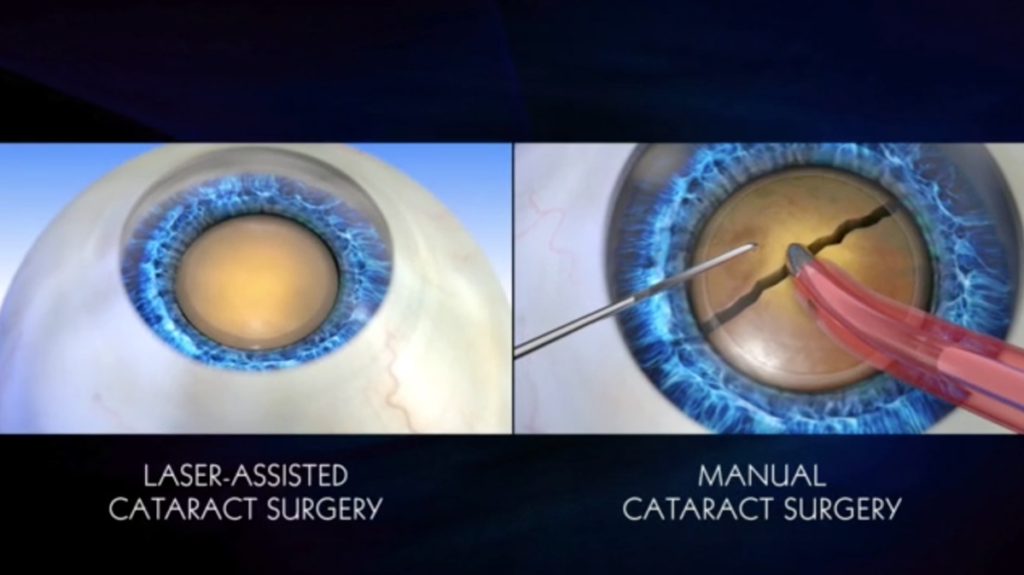At Loden Vision Centers, we understand that cataract patients have more options than ever when it comes to choosing a cataract procedure. After you’re diagnosed with cataracts, your first step should be to select an experienced surgeon who can help you decide on the best procedure for you and your lifestyle. Our team of knowledgeable and experienced surgeons has performed more than 100,000 vision procedures and are leaders in laser cataract surgery. But even before you meet with a surgeon, you should familiarize yourself with the differences between traditional and premium laser cataract procedures. We’ve outlined the process below to help you on your journey to seeing more clearly!
What Happens in Traditional Cataract Surgery?
In all cataract surgery procedures, the clouded lens of the eye, or “cataract,” is removed and replaced with an artificial intraocular lens (IOL). However, there are differences in the steps taken with a traditional cataract procedure compared with a premium laser cataract procedure.
1. In the first step, the surgeon uses a blade to make incisions in the cornea, the outermost layer of the eye. This gives the surgeon an opening for the instruments that will be used to remove your cataract. The placement and size of these incisions can affect the visual outcome, so it is important that these incisions are accurate and precise.
2. The second step in traditional cataract surgery is creating a capsulorhexis. The surgeon uses a handheld instrument to cut and gently create a circular opening in the sac that holds the lens, called the capsular bag or lens capsule. This gives the surgeon access to the cataract. Capsulorhexis is critical because it can affect how an implanted IOL will be positioned in the capsule. If the capsulorhexis is not done with a high level of accuracy, the position of the lens may not be ideal, leading to a less than optimal vision outcome.
3. The third step in traditional cataract surgery is called phacoemulsification (phaco). The cataract is manually broken up into small pieces in preparation for its removal. An instrument called a “chopper” may be used first to break up the lens into a few large pieces. Then, the phaco instrument is used to break up the lens using ultrasonic energy. Once the lens has been broken up or fragmented, it is removed using suction, and an IOL is placed into the capsule. The amount of ultrasonic energy can affect the recovery process and visual outcome, because too much ultrasonic energy released during this step may cause damage to the cells and tissue inside the eye.
What Happens in a Laser iCataract Procedure?
At Loden Vision Centers, we are experts in premium laser cataract surgery. In fact, Dr. James Loden invented the Laser iCataract™ procedure and was the first surgeon in the world to perform it! The premium Laser iCataract procedure replaces the use of blades and other instrumentation used in manual surgery with a laser, allowing your surgeon to provide you with the most advanced, precise, and accurate cataract procedure available.
- In the Laser iCataract procedure, the capsulorhexis is created first. Guided by a detailed image, your surgeon accurately places laser spots in a circular pattern to create the opening in the capsule. Because our lasers allow for accuracy during capsulorhexis, positioning of the new lens can be optimized, which can improve vision outcomes.
- The next step in the Laser iCataract procedure is to fragment the cataract into small pieces. Our lasers do this very efficiently, helping reduce the amount of time and ultrasonic energy needed during the phaco step to further break up the cataract before it can be removed. This reduction in ultrasonic energy may reduce the risk of certain complications and can potentially speed up healing time.
- The third step of the Laser iCataract procedure is the creation of corneal incisions. As in traditional surgery, these openings are needed for the instruments that will be used to remove the cataract.
- Following the laser portion of the procedure, phaco (phacoemulsification) is done to break up the fragments that were created by the laser and the cataract is removed in a similar way to traditional cataract surgery. A Lifestyle Lens is then placed inside the capsule. Loden Vision Centers offers a number of advanced lens options to help you reclaim the vision of your youth.
Why Choose a Premium Laser iCataract Procedure?
By deciding to have Laser iCataract surgery, you are getting the most advanced cataract procedure available. You can rest assured knowing you have the latest technology available to treat your priceless vision. At Loden Vision Centers, we recommend our Laser iCataract procedure for this reason – to provide patients with accuracy and precision, along with additional peace of mind.
There are two types of cataract surgery: laser-assisted & traditional.

Traditional and Premium Laser Cataract Surgery: Which Should You Choose?
Is a Premium Laser iCataract Procedure Right for YOU?
If you are interested in cataract surgery that treats your cataracts in the most technologically advanced and precise method available today, you may be a great candidate for the Laser iCataract procedure at Loden Vision Centers. Along with Laser iCataract surgery, Loden Vision offers a variety of Lifestyle Lenses to help improve your near, intermediate, and distance vision or your astigmatism, giving you the potential to see life more clearly!
Call Us Today to Learn More About Laser iCataract Surgery
Our knowledgeable staff is available to answer any questions you might have about premium cataract procedures. If you’ve been diagnosed with cataracts and want to learn more about your options, call Loden Vision Centers today at (615) 859-3937 to speak with one of our cataract specialists.


